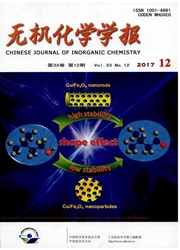

 中文摘要:
中文摘要:
本文用荧光光谱和紫外可见吸收光谱研究了在模拟人体生理条件下,偏钒酸钠与牛血清白蛋白(BSA)结合反应的特征,研究了紫外灯(253.7nm)照射对偏钒酸钠与BSA结合的影响。紫外吸收光谱显示,加入偏钒酸钠后,牛血清白蛋白的紫外吸收降低,表明偏钒酸钠与BSA形成了缔合物。荧光猝灭光谱显示偏钒酸钠对牛血清白蛋白有较强的荧光猝灭作用,荧光猝灭机理符合静态机制。缔合物的稳定常数分别为:Ks=0.357×10^4(25℃),Ks=0.667×10^4(30℃),Ks=1.437×10^4(35℃)。Forster偶极一偶极非辐射能量转移机理确定了偏钒酸钠在牛血清白蛋白中与第214位色氨酸残基之间的距离R=1.0695nm(25℃),R=1.0782nm(30℃),R=1.0806nm(35℃)。
 英文摘要:
英文摘要:
The interaction between NaVO3 and bovine serum albumin (BSA) was investigated by absorption spectrometry and fluorescence measurement. The binding constants were also obtained and the effect of UV C(253.7 nm) exposure on the values of binding constants was discussed. It is proved that the fluorescence quenching of BSA by NaVO3 is a result of the formation of NaVO3 complex in the solution. The mechanism of quenching belongs to static quenching and the association constants between NaVO3 and BSA are Ks=0.357×10^4(25℃),Ks=0.667×10^4(30℃),Ks=1.437×10^4(35℃). Based on the mechanism of energy transfer of dipole-dipole interaction between the donor and acceptor,we have determined the distance between 214-tryptophane residue of BSA and NaVO3 molecule to be R=1.0695nm(25℃),R=1.0782nm(30℃),R=1.0806nm(35℃).
 同期刊论文项目
同期刊论文项目
 同项目期刊论文
同项目期刊论文
 期刊信息
期刊信息
